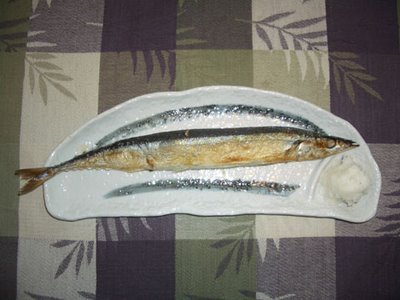Recently for my job, I was asked to design advertisement for "shape up goods" for a client in Japan. I used colorful small vinyl dumbbells as a key visual for the ad, since I thought they looked cute (ad was targeted mostly for dieting women) and made you think about excercising. But when I showed my design to the Japanese business team, they didn't seem to understand why I used dumbbells for the shape up ad. They thought that the ad represented more for excercise, and not for diet shape up.
I was confused as to why they were confused. After several minutes of trying to clear up each other, I learned that a lot of Japanese people don't necessarily consider exercising as a main source of diet. For them, dieting was drinking nasty green vegetable drinks or vinegars, or taking a hot bath, wearing some weird ring around your toes to make you look slimmer. It turns out that they were thinking more of massage creams and bath powders and nothing about exercising. Then I remembered that all my Japanese friends that were dieting weren't particularly working out, but instead trying out all these weird methods (I don't think any of them were losing weights).
One of the other popular method of losing weight amongst my Japanese friends were eating less meat and more fish. One of my coworkers who didn't particularly like fish, started eating sushi once a week instead of beef bowl. I think sushi can be quite high in cholestrol, especially when they are fatty.
Speaking of fish, one of the most traditional grilled fish you could get in Japanese restaurants (in Japan) was sanma (Pacific saury in English), especially in the Fall. It can be a bit of pain to eat, if you are not used to it as you need to semi-disect the fish as you eat, but they are also quite tasty so I think it's worth the time.
IN JAPANESE: Sanma no shioyaki
CATEGORY: Fish
COOKING METHOD: Grilled
DIFFICULTY: Medium
SERVES: 2 people
LENGTH OF TIME: 20 min
 INGREDIENTS:
INGREDIENTS:
A pack of sanma (Pacific saury), which usually comes in a pack of 4
salt
4-inch piece of daikon shredded (optional)
soy sauce or ponzu
HOW TO:
I've yet to see fresh sanma sold in the States. I get them in either Japanese or Korean markets, but they are always frozen. Since it's a small narrow fish, I would say one fish per person. If there are two of you, defrost two in the fridge for a few hours.
After the fish is fully defrosted, take them out of the fridge, and sprinkle salt all over on both sides of the fish and set aside for about 10 minutes (let the salt soak into the fish)
Set your oven to broil and place the fish on a rack with a pan underneath to catch drips (there will be a lot of drips!) Broil for about 7 minutes until the top is golden brown.
While the fish is being grilled, grate some radish (which I highly recommend for this fish). Squeeze the water out of the grated daikon and serve next to the fish. Pour some soy sauce over the daikon, and eat that with the fish.
The easiest way to dissect this particular fish is to cut it open in half from the top (using your chopsticks of course), and take the bones out. Now you are ready to eat!

4 comments:
Hey,
Just googled, found your sanma recipe.
Salt was good advice. thanks.
I also tried eating some of the fish with seaweed. I even put tabasco on it. not bad variations.
I really like the bottom half of the fish (less guts) than the top half with the head.
writing from Japan, where sanma/saury is one of the cleanest, smallest and cheapest fish on the market, another variation is to make tiny incisions in the fish before cooking, then marinating it in sake (or dry white wine) for a few minutes, or simply pouring some over the fish when grilling/broiling. I wonder if saury have high amounts of DHA, like sardines (iwashi) do. Saury do have a strong pleasant oceanic fragrance when cooked, suggesting that they are of the (healthy) oily variety. They are easy to clean before cooking: slit the belly and wash out the insides. Takes ten seconds.
> gabuchan
Thanks for the comment. Traditionally tabasco is not used in most Japanese dish, but I'm seeing it more recently, particulary on raw oysters. My wife also likes the bottom half of the fish, so she makes me eat the top half, LOL.
> don
That's a great advice. I put sake in almost everything I cook, but I've never tried pouring it for grilled fish. I also haven't tried cleaning the gut before grilling either. I will have to try that next time!
Just wanted to comment that sushi is not high in cholesterol (particularly not the bad cholesterol). Fat from marine animals has a positive effect on the cardio vascular system. certain tribes that eat nothing but fish, seal and whale blubber almost never suffer from heart disease.
Post a Comment